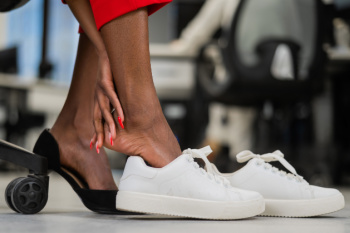
Foot and ankle stress fractures encompass various types, commonly occurring among athletes due to repetitive impact activities like running, jumping, or sudden changes in direction. These fractures result from the accumulation of microtrauma, leading to small cracks in the bones. Athletes often describe the sensation as a gradual onset of localized pain that worsens with activity and improves with rest. Stress fractures can occur in different areas of the foot and ankle, including the metatarsals, navicular, calcaneus, and fibula. Prompt diagnosis is important to prevent further damage and facilitate proper healing. If you have sustained a foot or ankle injury, it is suggested that you schedule an appointment with a podiatrist. A podiatrist can employ techniques like imaging studies, biomechanical assessments, and customized treatment plans. By providing targeted interventions and guidance on activity modification, podiatrists help shorten your time away from sports and expedite your return to activity with reduced risk of complications.
Stress fractures occur when there is a tiny crack within a bone. To learn more, contact Afsaneh Latifi, DPM from Lenox Hill Podiatry. Our doctor can provide the care you need to keep you pain free and on your feet.
How Are They Caused?
Stress fractures are the result of repetitive force being placed on the bone. Since the lower leg and feet often carry most of the body’s weight, stress fractures are likely to occur in these areas. If you rush into a new exercise, you are more likely to develop a stress fracture since you are starting too much, too soon. Pain resulting from stress fractures may go unnoticed at first, however it may start to worsen over time.
Risk Factors
- Gender – They are more commonly found in women compared to men.
- Foot Problems – People with unusual arches in their feet are more likely to develop stress fractures.
- Certain Sports – Dancers, gymnasts, tennis players, runners, and basketball players are more likely to develop stress fractures.
- Lack of Nutrients – A lack of vitamin D and calcium may weaken the bones and make you more prone to stress fractures
- Weak Bones – Osteoporosis can weaken the bones therefore resulting in stress fractures
Stress fractures do not always heal properly, so it is important that you seek help from a podiatrist if you suspect you may have one. Ignoring your stress fracture may cause it to worsen, and you may develop chronic pain as well as additional fractures.
If you have any questions, please feel free to contact our office located in New York, NY . We offer the newest diagnostic and treatment technologies for all your foot care needs.
 Athletes often experience heel pain due to the intense and repetitive stress placed on their feet during training. One common heel pain problem is plantar fasciitis, which is inflammation of the band of tissue running along the bottom of the foot. Another is Achilles tendonitis, which involves inflammation of the tendon that connects the calf muscles to the heel. These conditions can result from overuse, inadequate footwear, or improper training techniques. While most athletes respond well to conservative treatments like rest, stretches, and orthotics, there are times when these measures do not provide sufficient relief. In such cases, a podiatrist may suggest surgery as a last resort. Many factors go into deciding whether surgery is the best option, such as weighing the athlete's condition severity, pain levels, and impact on their performance and quality of life. If you are an athlete struggling with heel pain, it is suggested that you consult a podiatrist for a personalized treatment plan.
Athletes often experience heel pain due to the intense and repetitive stress placed on their feet during training. One common heel pain problem is plantar fasciitis, which is inflammation of the band of tissue running along the bottom of the foot. Another is Achilles tendonitis, which involves inflammation of the tendon that connects the calf muscles to the heel. These conditions can result from overuse, inadequate footwear, or improper training techniques. While most athletes respond well to conservative treatments like rest, stretches, and orthotics, there are times when these measures do not provide sufficient relief. In such cases, a podiatrist may suggest surgery as a last resort. Many factors go into deciding whether surgery is the best option, such as weighing the athlete's condition severity, pain levels, and impact on their performance and quality of life. If you are an athlete struggling with heel pain, it is suggested that you consult a podiatrist for a personalized treatment plan.
Many people suffer from bouts of heel pain. For more information, contact Afsaneh Latifi, DPM of Lenox Hill Podiatry. Our doctor can provide the care you need to keep you pain-free and on your feet.
Causes of Heel Pain
Heel pain is often associated with plantar fasciitis. The plantar fascia is a band of tissues that extends along the bottom of the foot. A rip or tear in this ligament can cause inflammation of the tissue.
Achilles tendonitis is another cause of heel pain. Inflammation of the Achilles tendon will cause pain from fractures and muscle tearing. Lack of flexibility is also another symptom.
Heel spurs are another cause of pain. When the tissues of the plantar fascia undergo a great deal of stress, it can lead to ligament separation from the heel bone, causing heel spurs.
Why Might Heel Pain Occur?
- Wearing ill-fitting shoes
- Wearing non-supportive shoes
- Weight change
- Excessive running
Treatments
Heel pain should be treated as soon as possible for immediate results. Keeping your feet in a stress-free environment will help. If you suffer from Achilles tendonitis or plantar fasciitis, applying ice will reduce the swelling. Stretching before an exercise like running will help the muscles. Using all these tips will help make heel pain a condition of the past.
If you have any questions please contact our office located in New York, NY . We offer the newest diagnostic and treatment technologies for all your foot and ankle needs.

Regular walking, with many people aiming for 10,000 steps a day, is beneficial for foot health, joint function, and overall mobility. Walking strengthens foot and ankle muscles, improves circulation, and enhances joint flexibility, reducing the risk of foot problems and arthritis. It also helps maintain a healthy weight, alleviating pressure on the feet, and preventing conditions like plantar fasciitis. Podiatrists play a vital role in guiding individuals toward safe walking routines. They assess foot biomechanics, recommend suitable footwear, and provide tailored exercise plans. Additionally, podiatrists detect early signs of foot issues and intervene promptly, ensuring optimal foot health. Incorporating regular walking, under a podiatrist's guidance, promotes healthy feet, joints, and overall mobility, whether reaching for 10,000 steps or simply embracing a more active lifestyle. If you want healthier feet and joints through a regular walking routine, it is suggested that you schedule an appointment with a podiatrist for guidance.
Exercising your feet regularly with the proper foot wear is a great way to prevent injuries and build strength. If you have any concerns about your feet, contact Afsaneh Latifi, DPM from Lenox Hill Podiatry. Our doctor can provide the care you need to keep you pain-free and on your feet.
Exercise for Your Feet
Exercise for your feet can help you gain strength, mobility and flexibility in your feet. They say that strengthening your feet can be just as rewarding as strengthening another part of the body. Your feet are very important, and we often forget about them in our daily tasks. But it is because of our feet that are we able to get going and do what we need to. For those of us fortunate enough to not have any foot problems, it is an important gesture to take care of them to ensure good health in the long run.
Some foot health exercises can include ankle pumps, tip-toeing, toe rises, lifting off the floor doing reps and sets, and flexing the toes. It is best to speak with Our doctor to determine an appropriate regimen for your needs. Everyone’s needs and bodies are different, and the activities required to maintain strength in the feet vary from individual to individual.
Once you get into a routine of doing regular exercise, you may notice a difference in your feet and how strong they may become.
If you have any questions please feel free to contact our office located in New York, NY . We offer the newest diagnostic and treatment technologies for all your foot and ankle needs.





